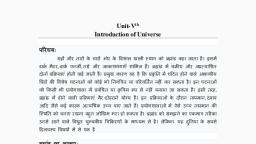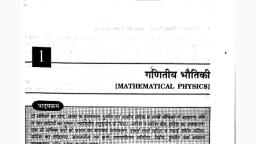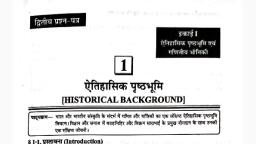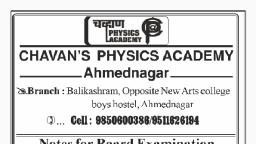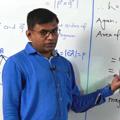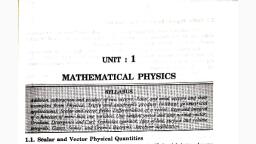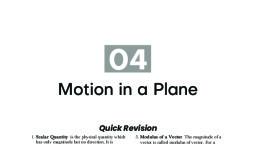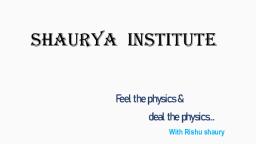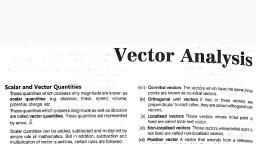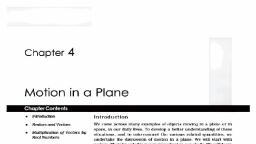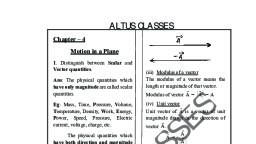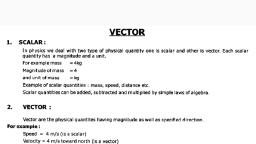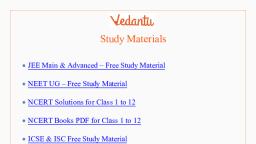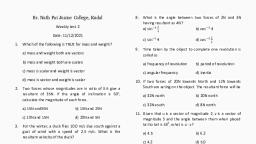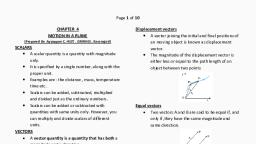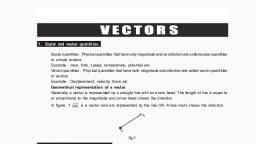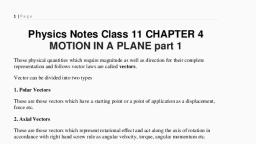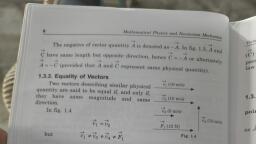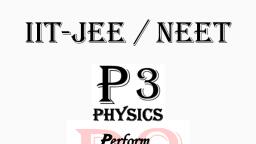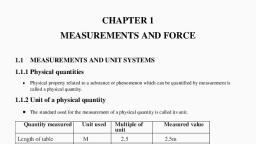Page 1 :
UNIT: 1, MATHEMATICAL PHYSICS, , , , , , 1.1. Sealar and Vector Physical Quantities, , The physical quantities which we can measure, are classified mainly in two classes :, (1) scalar quantities and (2) vector quantities.*, , (1) Scalar quantities or scalars—These are the physical quantities which are, expressed only by their magnitude. For example, if we say that the mass of a body is 5-0 kg,, it has a complete meaning and we are completely expressing the mass of the body., , Examples—Mass, length, time, density, volume, speed, temperature, potential, (gravitational, magnetic and electric), work, energy, pressure, quantity of heat, specific, heat, charge, electric power, frequency, angle etc., are the scalar quantities., , Thus, we need the following two things to express a scalar quantity completely :, , (i) Unit in which the quantity is being measured, and, , (ii) The numerical value of the quantity., , Remember that if the scalar is a pure number (like 7, e?, etc.) with no dimensions,, it will have no unit., , Scalar quantities can be added, subtracted, multiplied and divided by the simple, arithmetic methods., , Scalar quantity is symbolically written by its English letter. For example, mass is, represented by the letter m, time by ¢ and speed by v., , (2) Vector quantities or vectors—These physical quantities require the magnitude, as well as the direction to express them, then only their meaning is complete. For, example, if we say that “displace a particle from a point by 5 m”, the first question that, will arise, will be “in which direction” ? Obviously, by saying that the displacement is 5 m,, its meaning is incomplete. But if we say that displace the particle from that point by, 5 metre towards east (or in any other direction), it has a complete meaning. Thus, we, require the following three things to express a vector quantity completely :, , (i) Unit, (ii) Numerical value of the quantity, and (iii) Direction., , , , * ~ According to modern classification, each physical quantity is regarded a tensor of an order., The scalar quantities are represented only by one number, so they are said to be a tensor of, zero order, To express the vector quantities, we need 3 (= 3!) numbers, hence they are, called the tensor of first order. Similarly, some physical quantities such as moment of inertia, are expressed by 9 (=32) numbers, so they are said to be the tensor of second order.
Page 2 :
ified Physies : First Year (First Semester) 7, i tity along with its unit gives us the ma, Ttis tale oF ye and elt iris called the modulus orthe ven?, ofthat quanti soute value of the vector quantity., quant. 1 is the ah jcceleration, force, momentum, displacement, area, torgyg, moment of fore), mnagnetc Fel, electric field, ‘ravitational fed, weight, current dena, oe Mjplacement impulse, femperature Braden, the vector quanti not be added, subtracted and multiplied by the simple, , ities cant p, , raethods. Te. if two displacements are of magnitudes 10 metre, , tame responsive) Fev aum need not be 1S metre. We shall see ahead that thei pe, mae rePeare only when both ofthese displacements re {> the same direction. But, , these eine different directions, their sum can have any value betws, difference) and 15 metre (their sur, , 1m). Their resultant actually depends on the, aide, Thus, to add, subtract and multiply the vector quantities, we neq, a new algebra, , which is called the vector algebra. : ;, , Representation of a vector—A vector quantity is symbolically written either by its, , English tol tener or by the English simple leter bearing an arrow over it For example,, , vrei is represented either by the symbol v or by» foree as F of as F and so on,, “The magnitude of the vector quantity, within the two vertical bars. For exam}, , is written either by an italic letter or by a letter, ple, the magnitude of velocity is written either as, , yee | 7k The magnitude of force as For | F|and soon,, Graphical representation of a vector—A vector is graphically represented by a, araigh ine bearing an arvow. The length of the fine messures the magnitude of the, the arrow on it gives the direction. The starting point, , ‘vector on 2 convenient scale and, Soke lie is called the origin of fail and the end point is called the head or terminus,, , PO, the first letter P represents the origin and the second, , 2 | Uni, , velocity gradient, magnetic moment, , ay, In the vector notation A =, , =,, magnitude is same as that of the vector A, , =, = PQ, but the direction is reversed., , For example, if the velocity of a body, is 25 m s" towards north-east. To represent, , Jeter Q, the terminus. Obviously, if the origin and terminus of a vector,are inteschanged,, it graphically first we choose a convenient, scale, say Sms! = 1 cm. Then we draw a, , worm HEAD Q we get a new vector QP = B whose, +: / %, foRIGN, ‘coum straight line PQ of 5 cm length in north-east, Fig. 1.1. Vector representation direction (i.e, at an angle 45° from north, , towards east) as shown in Fig. 1.1 and then put an arrow on the head., , .2. Some Specific Vectors, ___ (2) Unit vector—A vector of unit magnitude is called a unit vector. A unit vector, is represented by a letter with a caret over it. For example, a unit vector in the direction, , of vector A is represented as A. Thus, a unit vector simply gives the direction., é rater., If the magnitude of vector A is | A | and the unit vector in the direction of, Bn, A is A, then ReiRia, , Mathematical Physies | 3, , he, unit vector of a vector K is expressed as below :, is, , Veet, A. We 1), , Magnitude | A |, Generally, we use the unit vectors i, j and k which are the unit vectors along, Xedirection (or east), Y-direction (or north), and Z-direetion (or vertically upwards), , respectively., (2) Zero vector—The vector of zero magnitude is called the zero vector, Le. the, , origin and the terminus of the zero vector coincide. It can have any direction. It is, , , , represented by the symbol 0., Thus | 0 | = 0 (zero). m, Need of zero vector : (i) On multiplying a vector A with scalar 2 = 0, we get, a zero vector ie, KA = 0 if k= 0 isa scalar., (ii) The sum of two equal and opposite vectors is a zero vector ie., R-A+B-0if A =-B, Properties of a zero vector : (i) On adding or subtracting zero vector from a vector,, , , , wwe get the original vector ie, A + 0 = A and similarly A-0 =A..., , Gi) Multiplying a scalar with a zero vector, we get a zero vector, ie, 4x 0 = 0., , @) Position vector—The vector which specifies the position of the body at any, instant with respect to a reference point, is called the position vector. The magnitude, of position vector tells the distance of the body at that instant from the reference point, and its direction is the direction of position of the body from 6, the reference point. It is denoted by the symbol r. For example,, in Fig. 1.2, the position of the body P at any instant with respect, to the reference point O is represented by the vector OP. Hence,, the position vector of the body P relative to the point O will, , ae, be 7 = OP., , (4) Displacement vector—The vector which tells us the magnitude of displacement, ofa moving body in a given time interval and also the direction in which it is displaced,, is called the displacement vector. It is denoted by the symbol $ . Obviously, this vector, is obtained by joining the initial position of the moving, body to its final position., , Suppose in Fig. 1.3, the position of a moving, body at an instant 4, is P and at other instant 4, is, Q. The displacement vector of the body in time interval, 1,~ 4, will then be represented by PQ with its origin, at P and head at Q, ie., displacement vector, , g-P, , , , Fig. 1.2. Position, vector, , , , Tt), , Fey), , Fig. 1.3. Displacement vector
Page 3 :
4 | Unified Physics: First Year (First Semester), Later on, we will see that ifthe postion of a body at an instant fis representeq, , Bs, by the vector Ob= 7G) and at the instant 1, by the vector OQ = F(1,), then, y . 5b x Ob - OP., displacement vector is PQ=02, S= ry)-r @) 12), , vector—A vector having its starting point or the point of application, xt, force etc. are the polar vectors because, , , , , , o, © Polar a, js called a polar vector. For example, displacement, to represent them, their starting point is required. . :, {6 Axial vector—A vector showing the rotation effect and in direction along the, sc of euation given by te right hand screw rule, is called the axial vector. For example,, ngular velocity, torque, angular momentum are the axial vectors, 1.3. Addition of Vectors, ‘Two vectors in a plane can be added by the following two laws :, (1) Law of triangle of addition of vectors, and, (2) Law of parallelogram of addition of vectors., (1) Law of triangle of addition of vectors, "According to this law, i/two vectors can be represer.ed in magnitude and direction, ty the two adiacent sides of a triangle in order, their resultant vector, in magnitude, aad direction is then represented by the third side of the triangle in reverse order., Suppose we are to add two vectors A and B as shown in Fig. 1.4. For this,, first we draw a vector A = PQ. Then at its head Q, keeping the origin of other vector,, , the vector B = QR (same both in magnitude and direction) is drawn. Then a vector, , , , % = PR is drawn joining the origin P of the first vector to the head R of the other, vector. This vector C = PR, then represents the sum of the two vectors A and B, , which is shown by the dotted line in Fig. 1.4. Thus, PQ + QR = PR or A+B=C, , , , ——, B, , , , Fig. 14. Addition of vectors, , It may be mentioned here that the vector © is also called the resultant vector, , of vectors A and B because the effect of vector © alone is the same as the combined, effect of the vectors K and B. The vectors A and B are, therefore, also called the, , components of vector C., 2) Law of parallelogram of vector addition, , According to this law, if two vectors are represented in magnitude and direction, by the two adjacent sides of a parallelogram, iis resultant vector in magnitude and, direction is then represented by the diagonal of that parallelogram, passing through, the point of intersection of those sides, , , , , , Mathematical Physics | 5, , , , Suppose we are to add the two vectors A and B shown in Fig. 1.5. For this,, , >, first we draw a vector A = PQ. Now keeping the origin of other vector at its origin P,, the vector B = PS (equal both in magnitude and direction) is drawn. Then complete, , the parallelogram PQRS taking PQ and RS as the two adjacent sides. Now a diagonal, PR is drawn passing through the point of intersection P of the sides PQ and RS, which will, , be the vector @, the resultant of vectors A and B, both in magnitude and direction, Le.,, , > > >» >» >» =, PQ+ PS=PR or A+ B=C, , *, , , , Fig. 1.5. Addition of vectors by the Isw of parallelogram, Equivalence of triangle law with parallelogram law of vector addition, InFig. 1.5, PQRS is a parallelogram with sides PQ and PS representing the vectors, R and B respectively. By the law of parallelogram of addition, PQ + PS = PR, But by the law of triangle of addition, PQ+QR= PR i), ‘Since the opposite sides of a parallelogram are equal and parallel, so they represent, the equal vectors. Hence, QR = PS., ‘Thus from eqns. (i) and (ii), it is clear that both the laws (triangle law and, parallelogram law) of addition of vectors are equivalent., Magnitude and direction of resultant vector by the law of parallelogram, of addition, In Fig. 1.6, PORS is parallelogram with its two adjacent sides PQand PS representing, the vectors A and B respectively. The diagonal PR represents the resultant vector, T both in magnitude and direction. To find the, magnitude and direction of the resultant vector C,, the side PQ is produced ahead and then @ normal, RM is drawn on it from the point R. Let the angle, between the vectors A and B be 0, ie,, ZSPQ = ZRQM = 6., Now in right-angled triangle RMP,, PR? = PM? + MR?, or PR? = (PQ + QM)? + MR?, PQ + QM? + 2PQ.QM + MR?, = PQ? + (QM? + MR?) +2PQ.QM, , , , Fig. 1.6. To know resultant by, law of parallelogram of addition, , >,
Page 4 :
6 | Unified Physics : First ‘Year (First Semester), , ‘But in rightsangled triangle Me, , 2, ant + MRS =o MO, , and oT pat + QR? + 2PQOR cos 0, . =, , \ee vesideeaitieiene, oo >,, , =<, , pop = ape Bea 2A TD Leoso Ala), , * gnitue of the resultant vector 2,, , “The above expression (1.3) gives the Mm!, , If the resultant vector C makes an angle with the vector A, then from 6, , i it RMP,, emg me we MR, tan o- pM 7 PQ*+ OM, But in right-angled triangle RMQ., sarge Re QR sin 8, wwe cos © = OF or om = QR cos 6, _ __QRsin@, ” tan & ~ BQ + QR cos @, , Bi sino, , sin, , ie an a= 14), | Al +] Bl cos @ 5, , “This expression (1.4) gives the direction of the resultant vector C. Thus, knowing, , the magnitudes | A | and | B | of the two vectors and the angle @ between them, the, , magnitude [| and direction, te, angle a of the resultant vector can be calculated with, , the help of equations (1.3) and (1.4)., Special cases : (0) If the two vectors X and B are in the same directions, , Ge, © = 0"), then, 1) = fide + Be + 218 11Blcos 0°, = Vike +iBe+2iAiB) Ce cos =, , > 2) 2.8,, (41-18) = |A|+|B| (maximum value), , and tana=0 or a=0°, Thus, the sum of two like vectors is equal 10 the sum of their magnitudes and, is in the same direction., , (Gi) If the two vectors A and B are perpendicular to each other, (/.e., © = 90°), then, , 11 = iAP + (BP +2/A |B] cos 90°, , Mathematical Physics | 7, , ot 1@) - xp +18 ( €03 90° = 0), (BI, , and tana= >, (Ri, , iil) Ifthe two vectors X and B are in the opposite directions (Le, 9 = 180°), then, , Z= Viae +1Be +214) /Bicosis0", = ike + (Bp - 21K 1/B) (~ eos 180° =D, , > oe, (&i-18i) = |A|-|B| (minimum value), , and tan a =0 or a= 0°, , Thus, the sum of wo opposite vectors is equal to the difference in their magnitudes, and is in direction of bigger vector., , (iv) If both the vectors & and B are equal in magnitude, ie. |A|=|Bl, then, , 12) = Vikp +1aP + 2)A 1A cos0, = > Cae, = 21X +0080) =| Al (+2c05%$-1) = 2/A|cos$, , , , : tong = —lAlsine___sin®, am an Sg Los, [A|+|A| e080, Box °, _ 2sinQeos$ sing, 22 8, 142c08?2-1 cos, , astiorun 2, ‘Thus if two vectors of of same magnitude are inclined at an angle 8, the magnitude of, their resultant vector is 2|| 035 and direction is which bisects the angle b between them., (¥) If both the vectors a and B are equal in magnitudes, (ie., IR 1=1 By ) and, , they are at an angle 8 = 120%, then, , (Cl = [Xp + [AP + 2A IAL cos 120°, , iRpeimeaiRI(-4), , = \ike =18), , [A| sin 120°, , cos 120° = — 5), , ¥3/2, , mary 78, , , , and wa - aS, JA] +A | cos120°, or a = 60°, , on
Page 5 :
ster), physics : First Year (First Seme, vo vectors equal in magnitudes and inclineg, , 7 ro the magnitude of either Vector and it biygat, , 8 | Unified, dant vector of, , Thus. ipo each othe, is eval, , thase vectors., , addition of more than two vectors, , mete method is that first we add tO vector,, ory the third vector to this resultant vector to pi, , are toad four vectors By Be and B as g, , example, Suppose WE, me f vector Bat the head of the vector X ang, , in Fig. 1.7, Fit we place the origin o, , dha theresa veto E by joining th, origin of vector, , the origin of vector A to the head of veety, @ on the head of vector E and ra the, of vector F to the head of vector €, Tey, F. and finally draw the resultant vector %, , B_ Now we ‘place the, F. by joining the origin, , resultant vector, ‘we place the origin of D on the head of, by joining the origin of vector F to the, sum of vectors A, B, C and D., , 2 >, R-K+B+C+D, , head of vector D which then represents the, , ie,, , , , Now if we look a Fig. 1.7 carefilly, we find that for adding the vectors 4,3,], , Z% and B, it is not necessary to draw the vectors E and F. Indeed to add more, than two vectors, the origin of second vector is placed at the head of first vector, the, origin of third vector at the head of second vector and so on; and then the resultant, vector is obtained by joining the origin of first vector to the head of the last vector., This method of addition of more than two vectors is called the polygon method of addition., , ‘Thus, according to the polygon law of addition, the resultant vector of more, than two vectors is represented by the vector which is drawn to complete the polygon, represented by the vectors to be added., , It may be mentioned here that if a closed figure is obtained on representing the, vectors acting at @ point by the arrow lines in order such that the origin of a vector, is at the head of its previous vector, the resultant of all vectors is a zero vector., Properties of vector addition, , ‘The following are the properties of addition of two or more than two vectors, sn fat tin obeys the commutative law—According to the onda, tes the ar of addition of two vectors is reversed, their resultant vector remains, , 2 > eS, A+B =B+Aa, , Mathematical Physics | 9, , In other words, if we add the vector B to the vector A or the vector A to, , the resultant vector is the same., , the veetor B,, >, 1m with its side PQ representing the vector, , Proof: In Fig. 1.8, PORS isa parallelogras, , , , , , ZK and the side QR representing the vector B zx R, In triangle POR, by the triangle law of addition, > > ee, PO+QR= PR or A+B = PR ..G) z =, But in parallelogram PQRS,, pp ek ee, PQ=SR= A and PS=QR=B, ‘Therefore in triangle PSR, by triangle law pl la, of addition, a, at eee SR, Seer oye «, PS+SR=PR or B+ A = PR -..Lii) Fig. 1.8. Commutative law, ‘Now from eqns. (i) and (ii), vector addition, K+B-B+k a5), , , , This is the commutative law of vector addition., , 2) Addition of vectors obeys the associative law—According to the associative, Jaw, the addition of three or more than three vectors is not affected, howsoever the, group of component vectors is made. i, (R+By+G-R+ +B +C), , ‘Thus, whether we add the vector @ to the sum of vector A and vector B or, we add the sum of vector B and vector C to the vector A. the resultant vector remains, , the same., Proof : Fig. 1.9 shows the addition of three vectors RB and a in which, , the vectors A, B and C are respectively represented by the lines PQ, QR and RS., , , , , , Fig. 1.9. Associ, It is clear that in triangle POR, PR= PQO+QR= A+B, and in triangle PRS, P= PR+RS=A+B+e 0, Similarly, in triangle QRS, W- Rr VB +S, i So Ne,, , and in triangle PQS, PS= PQ+QS = A+(B+C) <i), Hence from eqns. (i) and (ii),, , (K+By+ t= 8+ Bre) 6), , ‘This is the associative law of vector addition.

